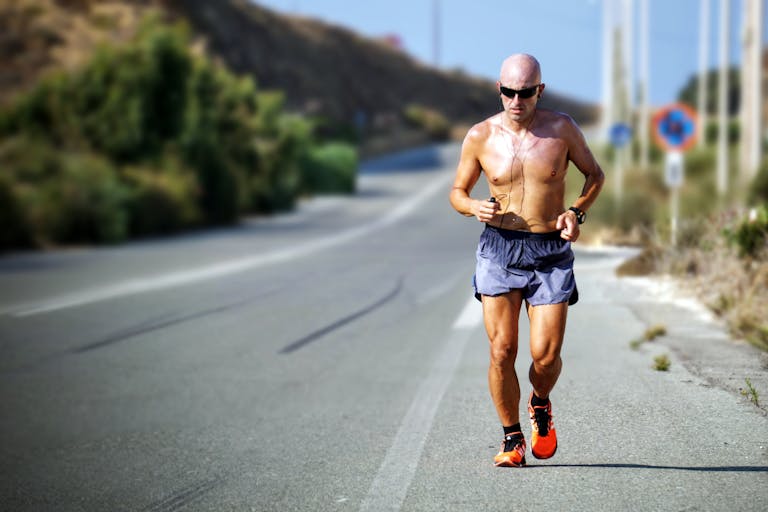Introduction
Running is a powerful way to stay fit, but it’s also one of the most common ways people end up injured, especially people who are new to running. At iMove Physio Rozelle and Panania, we help hundreds of runners each year overcome pain, stay moving and achieve their running goals!
Here are the top 5 running injuries we treat every week, and how we use advanced equipment—including VALD force plates, hand-held dynamometry, and high-speed running analysis software—to diagnose, treat and return you to running, stronger than ever.
1. Achilles Tendinopathy
What is it?
Achilles tendinopathy refers to irritation or degeneration of the Achilles tendon, typically caused by repetitive overload. It presents as stiffness and pain at the back of the heel—particularly during the first steps in the morning or after rest.
Common Causes:
- Sudden increases in running volume or intensity
- Weak or fatigued calf muscles
- Poor ankle mobility
- Running on hard surfaces or with unsupportive shoes
Symptoms:
- Morning pain/stiffness
- Pain during or after running
- A thickened or tender tendon
How We Treat It:
At iMove, our approach goes beyond basic stretches or rest. We use:
💡 We often find that runners with Achilles issues aren’t necessarily weak—they’re just not loading the tendon in the right way. Our tech helps pinpoint the exact deficit.
2. Patellofemoral Pain Syndrome (Runner’s Knee)
What is it?
Patellofemoral pain syndrome (PFPS) is pain felt around or behind the kneecap, often made worse by stairs, squatting, or sitting for long periods. It’s sometimes referred to as “runner’s knee.”
Common Causes:
- Muscle imbalances (especially quads and glutes).
- Poor control of the hip and knee during movement.
- Biomechanical overload from training or technique errors.
Symptoms:
- Aching under or around the kneecap.
- Clicking, grinding, or stiffness.
- Pain during long runs or walking downhill.
Our Evidence-Based Approach:
- Quadriceps and glute strengthening.
- Gait retraining.
- Activity modification (not just “rest” – we pride ourselves on keeping you active, even whilst injured).
📍 If you’re looking for a running physio in Rozelle or Panania, our clinic offers these assessments as part of every injury consultation—helping you feel stronger and move with more confidence.
3. Iliotibial Band Syndrome (ITB Syndrome)
What is it?
ITB syndrome is one of the most common causes of outer knee pain in runners. It results from excessive friction of the ITB (a thick band of connective tissue) over the outer femur.
Why It Happens:
- Weak glutes or poor hip control.
- Sudden spikes in training.
- Excessive downhill or track running.
- Tightness in the hips or quads.
Typical Symptoms:
- Sharp pain on the outside of the knee.
- Discomfort that worsens with running, especially downhill.
- Pain that starts partway into a run and builds.
Our Treatment Framework:
💡 Many runners foam roll the ITB directly, but that rarely helps long-term. We focus on treating the cause, not just the tightness.
4. Shin Splints (Medial Tibial Stress Syndrome)
What is it?
Shin splints cause pain along the inner edge of the shinbone (tibia) and are common in newer runners or those who ramp up training too quickly.
Why They Occur:
- Sudden increase in running frequency or volume.
- Overuse of foot and ankle muscles.
- Flat feet or poor foot control.
- Worn-out or unsupportive shoes.
Symptoms:
- Dull, diffuse ache along the shin.
- Pain that improves during warm-up but worsens later.
- Tenderness along the medial tibia.
Our Strategy:
- Calf raises and foot intrinsic work.
- Glute and hip strengthening.
- Tailored return-to-run program based on your specific needs.
👟 Many shin splint cases stem from doing too much, too soon. We help you build up tolerance safely and with objective data to back it up.
5. Lower Limb Bone Stress Injuries
What is it?
These include stress reactions or stress fractures in bones like the tibia, femur, or metatarsals. They’re caused by repetitive loading that outpaces your body’s ability to repair microdamage.
Why They Occur:
- Under-fuelling or low energy availability.
- Training errors (e.g., high mileage, poor recovery).
- Biomechanical overload.
- Hormonal or menstrual irregularities.
Symptoms:
- Focal, pinpoint pain in the bone (although some bone stress injuries can also feel quite vague).
- Pain that worsens with weight-bearing.
- Night pain or discomfort with walking.
Our Treatment Approach:
🧠 This injury requires a full-body and lifestyle approach—nutrition, strength, rest, and training all matter here.
Technology-Driven Running Physio in Rozelle & Panania
At iMove Physio, we combine clinical expertise with the latest technology to help you run pain-free and perform at your best. Our clinics are equipped with:
✅ VALD Force Plates
Used to assess:
- Single-leg power and strength asymmetries.
- Tendon loading capacity.
- Jumping mechanics and landing forces.
- Return-to-run readiness.
✅ Handheld Dynamometry
Allows us to:
- Objectively measure true strength in your glutes, calves, quads, and hamstrings.
- Monitor progress across your rehab journey.
- Take the guesswork out of your exercise prescription.
✅ High-Speed Running Gait Analysis
We use specialised running analysis software to:
- Detect stride inefficiencies or risk factors.
- Track changes in cadence, hip position, foot strike, and more.
- Give clear feedback to improve form and reduce injury recurrence.
Ready to Book Your Running Assessment?
If you’re dealing with one of these common injuries—or just want to make sure you’re running efficiently—our team of running physios in Rozelle and Panania can help.
📞 Call us or 📲 [Book online] to start your running rehab journey today.


